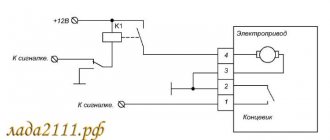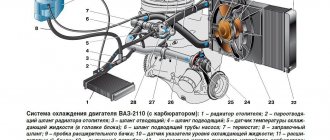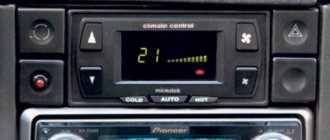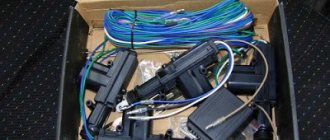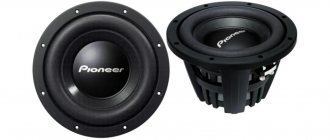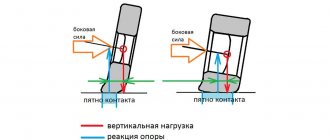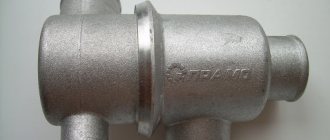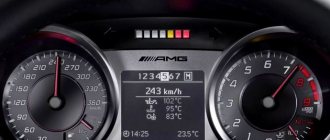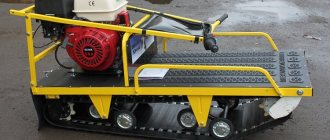Climate control and air conditioning are innovative modern systems for thermoregulation of air in the car interior. But these two systems have different climate control technologies, and this can affect the comfort of passengers, as well as the operation of the car as a whole.
Just 10 years ago there simply wasn’t such a choice of technologies; before, car owners simply opened the window, and thus the interior was ventilated. Today you won’t surprise anyone with an air conditioner in a car, well, perhaps only by the absence of an air conditioning system.
In this article we will tell you in detail what advantages these systems have, and also compare them according to the main criteria.
Why do you need air conditioning in a car?
First of all, air conditioning is necessary to create comfort, so you can enjoy a pleasant atmosphere on a hot day. Therefore, passengers do not need to open the car windows; they just need to set the temperature. Plus, such an atmosphere in the cabin will have a good effect on the well-being of the driver and passengers.
In the hot season, many drivers suffer from fatigue while driving; if the car has air conditioning, then you won’t be afraid of it. Because the atmosphere created by it increases the performance of the brain, as a result of which there will be significantly fewer accidents on the road. Therefore, if previously air conditioning was some kind of luxury in a car, now it is simply a necessary system.
The bottom line is that in the summer, especially in large cities, it is simply impossible to stand in the sun in a traffic jam; there will be no escape from the merciless sun and you can even faint from overheating. That is why air conditioning in megacities is simply a vital necessity.
Car air conditioner
Almost every one of us has a split system hanging on the wall at home. However, a car air conditioner is significantly different from household equipment. The device is powered not by electricity, but by rotation of the crankshaft via a belt drive. Air conditioners are designed only to cool the air in the cabin. In summer, to adjust the intensity of operation of this device, it is necessary to change the fan speed. The faster the fan rotates, the sooner the air will become comfortable. If it is necessary to heat the air, then the stove starts up, and the warm air is dispersed throughout the cabin using the same fan. It should also be noted that when the air conditioner operates, it first takes in air, then dries it, and only then will the flow be heated or cooled.
Air conditioners in modern cars are controlled using mechanical or digital control systems. It all depends on the make and model of the specific car.
How does air conditioning work in a car?
According to the principle of operation, an air conditioner is similar to a regular refrigerator, although their internal structure is noticeably different. The main difference is only in the design part, but in general the technological process is similar to that of a household refrigerator. It is a closed system through which freon circulates. It needs to be changed sometimes; this can be done at a specialized car service center.
When the air conditioning activation button is pressed, the electrical clutch is activated. Using a pressure disk, it connects the pulley and the air conditioning system. The pulley rotates continuously and is driven by a belt drive from the crankshaft.
Then, when the docking is successful, the compressor starts working, its function is to compress the freon. When the refrigerant is compressed, it becomes very hot and enters the condenser. A condenser is a unit that is a radiator; here, hot freon vapors are cooled using a fan. It is usually set at 1st speed, when the car is driving on the highway, the cooling effect increases significantly.
The principle of operation of a car air conditioner
If the car is stuck in a traffic jam, the sensors will be able to record that the productivity of the system has decreased. And then the control unit will switch the condenser fan to the second rotation speed.
When the freon turns into a liquid state, it will then be redirected to the cabin. But before this, the refrigerant enters a special unit of the system - the evaporator. Here the substance boils and becomes steam again, and during this process the temperature of the freon drops significantly.
This cold will later be used to cool the car interior. After this, the cold steam enters another radiator, where the cold is accelerated by a fan and enters the car interior. Next, the refrigerant again enters the compressor and this heat exchange cycle is repeated.
Operating principle of the air conditioner
According to the principle of operation, the air conditioner resembles a regular refrigerator, representing a closed system of tubes with freon distilled through them. After activation of the air conditioning system, the compressor is responsible for compressing the refrigerant.
During engine operation, air vapor enters the condenser, which cools it. Usually this unit coincides with the first gear of the transmission, so as the speed increases, the cooling effect also increases.
In traffic jams, the system detects a decrease in the intensity of vehicle operation, which results in a transition to second speed.
However, cooled freon enters the cabin only after it passes through a special evaporator, which turns the liquid into steam using a fan.
Then this steam again enters the air conditioning system, continuing to circulate in a circle.
Benefits of air conditioning
The main advantage of an air conditioner is that it saves you from overheating in the summer. To do this, just turn it on at the required power and the flow of hot air, passing through the ventilation system, will cool and the cabin will become cool.
Disadvantages of air conditioning
As it turned out, the air conditioner has much more disadvantages than advantages:
1. The air conditioner requires careful maintenance, constant inspection of pipe connections and monitoring of the refrigerant level.
2. Prolonged use of air conditioning significantly increases fuel consumption.
3. Since the air in the cabin is cooled by the ventilation system, a draft may occur. It won't take long for you to catch a cold from such drafts.
4. Expensive repairs of the air conditioner and its components.
These are the main differences between an air conditioner and a climate control system. When choosing a car with one control or another, you need to be guided by the characteristics of each of them and personal preferences.
Pros and cons of car air conditioners
All car air conditioners are divided into two categories: electrical and mechanical, and each of these types has its own pros and cons, which we will discuss further.
Advantages of mechanical air conditioners:
- Increased efficiency when driving the vehicle.
- Small size.
- No harm to the environment.
Disadvantages of mechanical systems:
- Fuel consumption increases by about 30 percent.
- Very difficult installation.
- Works only when the engine is running.
- The air conditioning system is not perfect and cannot meet the requirements of all passengers. For example, if one passenger is hot and the other is cool, then some kind of compromise will have to be reached.
Advantages of electric air conditioners:
- Installation does not take much time and effort.
- There is a useful “night mode” function.
- The efficiency is much higher.
- Can be operated from a cigarette lighter or a standard outlet.
Disadvantages of electric air conditioners:
- The cost of such equipment is much higher.
- Replacing freon in such an installation will be problematic.
- It is impossible to regulate the temperature of the supplied air, you can only change the degree of supply.
- It's very easy to catch a cold while traveling, for example, if you get carried away on the road and don't turn off the air conditioning.
- The air conditioner produces a sharp stream of air, which is annoying. Compared to climate control, it is much quieter.
Advantages and disadvantages of air conditioning
For ease of understanding, we will divide the strengths and weaknesses of the component into several lists.
Drivers like:
- the ability to cool the air at high temperatures behind the windshield;
- increasing the level of attentiveness and reaction due to comfortable conditions in the cabin;
- fighting car air conditioning with unpleasant odors (tobacco, alcohol);
- dehumidification of air in unfavorable weather conditions (prevents windows from fogging).
Flaws:
- reduction in power of the driving unit;
- increased temperature under the hood (there is less free space);
- frequent maintenance of the component parts of the device, their rapid wear;
- increased fuel consumption.
The disadvantages are compensated by the obvious low cost of installing an analogue cooling system.
How to avoid catching a cold from air conditioning
Doctors warn that if the body experiences temperature stress (that is, the temperature changes sharply from high to lower), health problems may arise. A runny nose, cold, or even an allergic reaction may occur as microorganisms can accumulate in the air conditioner.
To avoid catching a cold, you should change the temperature in the cabin gradually, so you should not immediately turn on the maximum power. In addition to this rule, you need to remember one more important recommendation - under no circumstances should you open windows while the system is running.
The reason lies in the fact that open windows will create drafts, which definitely do not bode well.
How to avoid getting sick under car air conditioning
Climate control and air conditioning in the cabin are not a guarantee that the cabin will be as comfortable as possible. It is necessary to be able to use these systems correctly so that the temperature is comfortable, but nothing more. If it is too low and it is very hot outside, there is a huge chance of catching a cold. To prevent this from happening, it is necessary to abandon low temperature conditions. To avoid getting sick, the temperature should be set 5 degrees lower than outside. On long trips it can be reduced, but this is done gradually every 2 hours. Then the temperature will be as comfortable as possible, and the risk of a cold will be minimized. In winter, the climate control is adjusted so that the cabin does not get hot. Going outside poses a serious risk of getting sick. Often climate systems are set to 22-26 degrees in winter.
What is better: climate control or air conditioning for a car in winter? Definitely the climate, because the driver will not be constantly adjusting the temperature and distracted from the road.
What is the difference between climate control and air conditioning?
To put it in simple words, climate control is the same as an air conditioner, only it is fully automatic. It should be mentioned that in addition to the cooling function, the climate control also has the ability to heat the interior space.
The innovative climate system reads readings from sensors located around the entire perimeter of the cabin. In the future, the owner sets the required temperature, the information is saved and in the future the temperature will not rise above the specified value.
Definition of concepts: air conditioning and climate control
If we try to briefly talk about the difference between an air conditioner and a climate system, then the first thing we need to say is that these are completely different terms, which many people often confuse and do not know whether there are differences between climate control and air conditioning in a car. And this confusion is not surprising - both solutions have similarities and solve similar problems. These systems are designed to maintain a comfortable temperature in the cabin. But it must be said that air conditioners appeared much earlier. Therefore, let's start with them.
Pros and cons of climate control
- The ECU responds very promptly to temperature changes and therefore stabilizes it in a short time. Let's say you opened the door and warm air entered the cabin, the sensors are very sensitive, so in a matter of minutes the temperature will return to normal.
- All actions to stabilize the climate in the cabin occur automatically. You won't have to periodically turn the controls based on your feelings.
- Since the air cooling function is periodically switched off, fuel is greatly saved.
- The driver can focus all his attention on the controls and not on setting the air conditioning system.
A significant disadvantage of the climate control system is that it costs 1.5-2 times more. Because of this, motorists still argue to this day about whether the high cost of climate control is justified.
We achieve maximum efficiency of climate control
In addition to correctly setting up the climate control system and its availability, you also need to create the right conditions inside the car. First of all, you need to pay attention to the condition of the radiator-evaporator. If you do not regularly clean its surface, pathogenic bacteria can form there, which can subsequently cause diseases of the respiratory system of people who often travel in such a car. This cleaning is quite simple, so you just need to do it from time to time and such a problem will not arise.
In order for both air conditioning and climate control to work with maximum efficiency, it is best to organize the following conditions in the car interior:
In this case, the operation of the air conditioning system and climate control in recirculation mode will be as efficient as possible. Of course, the recirculation mode is very convenient and saves the car’s energy, which would have to be spent on cooling or heating the air that entered the air conditioning system from the street, but once every 10-15 minutes you need to turn off this function for a short time to give fresh air access to the cabin . But you should not do this if you are driving through a smoky section of the road.
It is also worth taking air from the street after the car has been parked for a long time in the summer, since otherwise it will be too hot in the cabin and the recirculation mode will not be energy-saving, but on the contrary, it will only lead to an increase in fuel consumption. However, after even a slight decrease in the temperature in the cabin, the recirculation mode can be turned on.
Where is it easier to control: air conditioning or climate control
Operating a standard air conditioner is not at all difficult; even a person who has no knowledge of cars can handle it. As a rule, the control panel has a compressor start button and two regulators. One is responsible for the power of the fan, and the second can regulate the temperature; for this there is a division into red and blue zones.
If we consider climate control, then all the work is done by smart electronics. That is, the system collects data from sensors, analyzes it, and subsequently maintains the temperature. All that is required from the car owner is just to set the required temperature. Everything else is done automatically, so you don't have to think about it.
What is more economical - air conditioning or climate control?
It will not be possible to choose a leader right away, since this is a rather difficult and controversial issue. Let’s say if you buy a new car, the version with climate control will cost more.
But at the same time, if you take a car with a conventional air conditioner, then on the one hand you will save money, but on the other hand, this air conditioner will take a long time to set up. Judging by the fuel consumption, the climate control eats up a little more, but this is counterbalanced by the fact that it is a smart system and will not need to be constantly monitored.
Therefore, you need to make a choice yourself; before doing so, you need to carefully weigh all aspects. You can also focus on your financial situation, or tastes and needs.
Types of climate control systems
There are different modifications, and therefore the system can be divided into 1, 2, 3 or 4 temperature zones. High-precision temperature sensors help her in this; they transmit readings to the computer. In the future, the pre-specified temperature will be stably maintained in a separate zone.
Example of temperature zones in a climate-controlled car
For example, we have a 2-zone control system, and this tells us that the temperature will be different in all parts of the car interior. According to the standard, one zone is located near the driver, and the second is located next to the passenger.
How does climate control work in winter?
Vehicle configurations are different, so the operating modes will be different. Typically, differences in performance can only be detected in winter.
So, for example, when you get into your car in the morning, you will find that the deflectors are first directed at the windows, warming them up, and then turn towards your feet. Subsequently, the air flow will gradually adjust and will be directed towards the driver’s face. Driving the car will then be much more pleasant and comfortable.
You need to understand that the systems come in different modifications, so the operating algorithm may be different in different cars.
The problem may be that the heating may be different in some models. Moreover, some modifications can be configured independently, while others can only be configured by specialists.
Some systems refuse to start the system at all, and all because the windows in the car are fogged up. These are serious defects of the manufacturers, and therefore you may accidentally stumble upon something like this. Therefore, you should pay special attention to all the features of climate control, otherwise you may face serious difficulties after purchasing a car.
Sometimes you may encounter difficulties with the system, and an error code will be displayed on the panel, and in this case you need to understand what is going on, below you can see the table with common errors.
